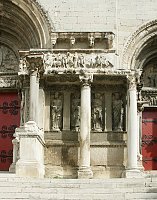
|
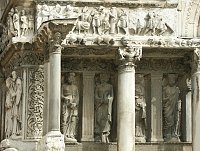
|
Scenes depicting Christ before Pilate, the flagellation, and the damaged scene of Simon carrying the crossOn the far left in the center image, seen in part above the capital, Jesus is being brought before Pilate. Pilate sits regally in his throne. |
| |
|
The flagellationAll four of the Gospel writers write briefly about Christ's scourging, ordered by Pontius Pilate, the governor of Judaea. Jesus is represented a second time on this panel in this scene of flogging, here with a bare back and exposed ribs. Two soldiers are flogging him; some remains of the whips are still visible in the relief. These poses are realistic with the implied motion in the soldiers and with Christ's slumping pained figure. |
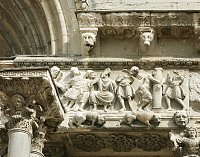
|
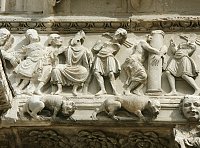
|
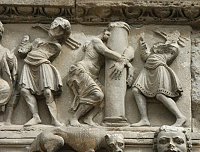
|
| |
|
Simon's carrying of the crossThis damaged scene was identified thus by Stoddard. Mentioned in three of the Gospels, a man named Simon of Cyrene came onto the scene where Jesus was carrying the cross and the soldiers compelled him to carry the cross of Jesus. |
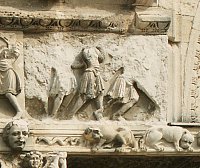
|
| |
|
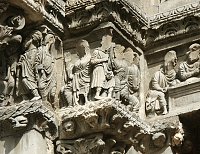
|
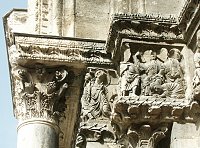
|
The MagdaleneThis scene refers to the Mary, a penitent harlot who arrives at a dinner with Jesus and Simon. She has brought oil and weeps at Jesus' feet, which she wipes with her hair and then kisses and anoints them with oil of myrrh. Judas may be one of the figures who points at her since he objected to wasting the ointment. |
| |
|
The lintel of the right tympanum with the three Marys at the tombThis incident is mentioned in all four Gospels. These holy women, companions of the Virgin, arrived early at the sepulchre with spices and aromatic oils to anoint the body but discovered that the stone sealing the tomb had been removed and the body was gone. An angel told them that Christ had risen. This scene depicts first the woman purchasing the spices and the three again at the tomb where soldiers sleep and an angel with enormous wings tells them the news. The detail is outstanding in this scene with the chain mail, swords, and shields of the soldiers and the decorated borders of the angel's gown and elaborated feathers of the wings. |
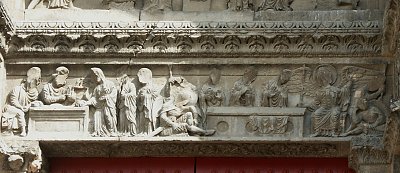
|
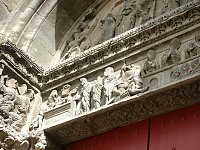
|
| |
|
| The depiction of the Marys buying spices is unusual as O'Meara explains: "The genre details of counter, scales, ampullae and even two spice merchants are too vividly detailed to be explained solely on the basis of the gospel passage. . . . this motif is an especially appropriate expression of the pharmaceutical interests of the Knights Hospitallers, who were domiciled at Saint-Gilles and who played an important role in the life of that monastery" (140). |
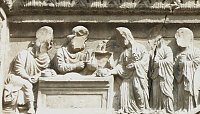
|
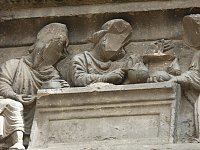
|
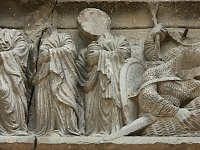
|
| |
|
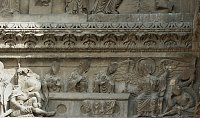
|
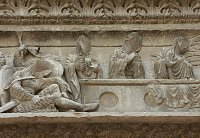
|
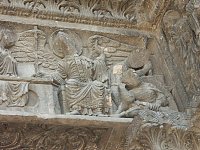
|
| |
|
Around the corner: Meeting of the Disciples on the way to Emmaus |
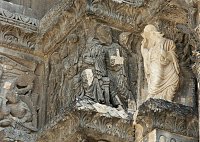
|


 Go to Saint-Gilles Index.
Go to Saint-Gilles Index. Click here to return to index of art historical sites.
Click here to return to index of art historical sites.
 Click here to return to index of artists and architects.
Click here to return to index of artists and architects.
 Click here to return to chronological index.
Click here to return to chronological index.
 Click here to see the home page of Bluffton University.
Click here to see the home page of Bluffton University.

